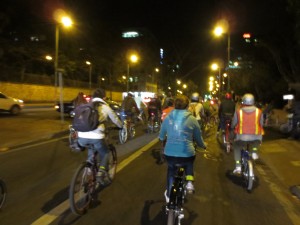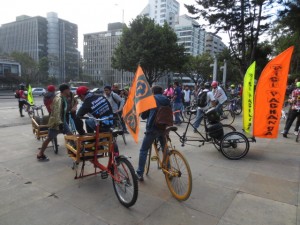 During the past few years, bicycle colectivos have been sprouting up all over this city. A bicycle colectivo is a group of cycling enthusiasts who organize activities that express their love of the “caballito de acero,” or the “little iron horse” as many here affectionately refer to their bicycles. The basis of most colectivos is the organization of non-competitive group rides on city streets. Some of the hundred or so colectivos are formally organized and registered with the government, and others are informal. The largest and most seasoned of these is the group Ciclopaseos de los Miercoles, who organize a critical-mass style ride that attracts several hundred people on Wednesday evenings to explore some part of the city. The idea is partly to help riders gain confidence riding in traffic and see parts of the city they might not otherwise see because of fear, or distance from their home. The other part is to demonstrate to non-cyclists that cyclists are having fun…and are a relevant actor on city streets.
During the past few years, bicycle colectivos have been sprouting up all over this city. A bicycle colectivo is a group of cycling enthusiasts who organize activities that express their love of the “caballito de acero,” or the “little iron horse” as many here affectionately refer to their bicycles. The basis of most colectivos is the organization of non-competitive group rides on city streets. Some of the hundred or so colectivos are formally organized and registered with the government, and others are informal. The largest and most seasoned of these is the group Ciclopaseos de los Miercoles, who organize a critical-mass style ride that attracts several hundred people on Wednesday evenings to explore some part of the city. The idea is partly to help riders gain confidence riding in traffic and see parts of the city they might not otherwise see because of fear, or distance from their home. The other part is to demonstrate to non-cyclists that cyclists are having fun…and are a relevant actor on city streets.
As a new book published in honor of the colectivos by the city’s culture, sports, and recreation department (El Libro de la Bici de Bogotá) attests, not all bicycle colectivos are focused on organizing fun rides in the city. Others are focused on restoring old bikes; providing training so that an underrepresented group, such as women or kids, can learn how to ride bikes safely in the city; spreading information about bike issues on the internet; promoting a stronger linkage between environmental activism and cyclists; or pressuring city government to support new pro-bicycle policies or perform the necessary maintenance on the extensive bicycle system that is already there.
 Not all bicycle colectivos consider themselves politically-active or get involved in political processes related to bicycle transportation. But through their creation and involvement in colectivos, urban cyclists have been gaining new recognition as a social force. Colectivos have also been seeking and earning a voice in the politics of urban mobility, most recently in a new decree project promoting bicycle parking and cyclist safety in the Bogotá city council. The current mayor, in dialogue with pro-bike activists, has integrated bike issues into his development plan, and bike activists have even been hired in key positions in the city’s mobility bureaucracy. It is the bike colectivos that are helping shape and define the emergence of a new political consciousness and “bici-activismo” here. I have been tracking the different expressions of this activism in my research.
Not all bicycle colectivos consider themselves politically-active or get involved in political processes related to bicycle transportation. But through their creation and involvement in colectivos, urban cyclists have been gaining new recognition as a social force. Colectivos have also been seeking and earning a voice in the politics of urban mobility, most recently in a new decree project promoting bicycle parking and cyclist safety in the Bogotá city council. The current mayor, in dialogue with pro-bike activists, has integrated bike issues into his development plan, and bike activists have even been hired in key positions in the city’s mobility bureaucracy. It is the bike colectivos that are helping shape and define the emergence of a new political consciousness and “bici-activismo” here. I have been tracking the different expressions of this activism in my research.
The bici-activismo that is taking shape is set against a backdrop of a city that does not have a strong tradition of citizen activism. As one of the city’s influential alternative transportation advocates has observed, “Colombia has never been characterized for its bursting citizen participation. Like the good conservative country it is, people are fine wearing a pro-something t-shirt or donating $10 a month to Unicef and saying ‘I participate.’ As for the rest, all that was needed was a fifty year war of the FARC to produce a massive mobilization, that has never happened more than once, against this movement. For other themes, little or nothing has been seen.” It is also set against a backdrop of concern that the extensive bicycle system and gains for cyclists during the Mockus and Peñalosa mayorships in the 1990s and early-2000s have been neglected by subsequent city administrations, and that if cyclists don’t defend and promote bicycle interests the possibilities for urban bicycle use will continue to deteriorate.
 This weekend, one modest expression of the power of the bicycle colectivos was on display, in an event that took place to celebrate the World Day of Recycling called “Reciclovía,” a combination of the word “recycling” with “cycle way.” The event was convened by a citizen environmentalist colectivo, Bogotá Basura Cero (Bogotá Zero Trash), which wanted to bring public attention to the importance of recycling. How to do that? Invite the bicycle colectivos!
This weekend, one modest expression of the power of the bicycle colectivos was on display, in an event that took place to celebrate the World Day of Recycling called “Reciclovía,” a combination of the word “recycling” with “cycle way.” The event was convened by a citizen environmentalist colectivo, Bogotá Basura Cero (Bogotá Zero Trash), which wanted to bring public attention to the importance of recycling. How to do that? Invite the bicycle colectivos!
Responding to the invitation which was diffused through Facebook and Twitter–the critical organizing tools of bici-activistas here–late last Saturday afternoon, dozens of bicycle colectivos convened their members and other interested cyclists at one of five gathering points throughout the city. From these points, escorted by a colectivo like Ciclo Paseo de los Miercoles or young police officers on bicycles, each group rode to the city’s central park, Parque Simón Bolívar, a trip of anywhere between three and ten miles. The group I rode with had about sixty riders when we started and gained another thirty or so as we traveled.
Once everyone converged on the park from around the city–perhaps three hundred or so people in total–everyone was allowed to ride in the park, which is usually closed at night. A pedal-powered concert at a nearby mall followed. It was a ludic event, full of fun, laughter, and good times. At the front of the pack setting the tone was Bici Pachanga (Bike Party), a colectivo of about a dozen costumed riders mounted on exotic cargo bikes or fixies, and a tricycle with a sound system blaring techno-cumbia party music. Their participation was electrifying and drew a lot of attention from others sharing the streets.
 But there were also political assertions at work here. Colectivos with widely different attitudes toward the bicycle put aside whatever differences they have with each other, and by the hundreds put their bodies out into traffic, disrupting the flow of automobile and bus traffic, communicating that they too deserve space on the roads. It also brought together two nascent citizen activist communities–urban environmentalists and cyclists–who have been working in solidarity together in recent years, to affirm their common goal of producing a cleaner city. All of this was on visual display, and the political message was hard to miss.
But there were also political assertions at work here. Colectivos with widely different attitudes toward the bicycle put aside whatever differences they have with each other, and by the hundreds put their bodies out into traffic, disrupting the flow of automobile and bus traffic, communicating that they too deserve space on the roads. It also brought together two nascent citizen activist communities–urban environmentalists and cyclists–who have been working in solidarity together in recent years, to affirm their common goal of producing a cleaner city. All of this was on visual display, and the political message was hard to miss.
But there was another kind of power at work here as well, since the event also drew the official recognition and logistical support of various government institutions–the National Police, the city’s Institute of Sport and Recreation–as well as a major commercial center where middle class people shop–all in ways that traditionally marginalized cyclists don’t often experience.
There are many obstacles to bici-activismo here, ranging from political apathy of many citizens to the challenges of doing volunteer organizing when it means putting livelihood concerns to the side. Or the waxing and waning interest on the part of politicians in the plight of the bicycle (currently waxing). And the cultural perception that bicycles are for the poor, and everyone should aspire to own cars. But as a new site of citizen political consciousness takes shape around the bicycle, the forms of power that bici-activistas mobilize will be important to watch.
May 19, 2014 at 8:10 pm
[…] By Luis Vivanco […]